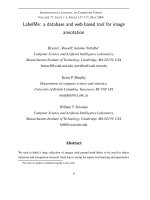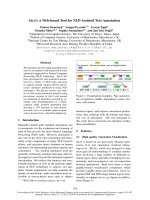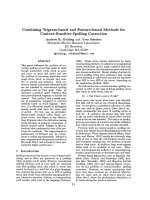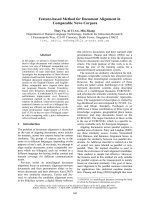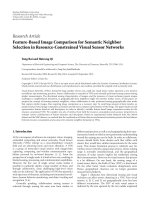Feature based tool condition monitoring for milling
Bạn đang xem bản rút gọn của tài liệu. Xem và tải ngay bản đầy đủ của tài liệu tại đây (3.95 MB, 152 trang )
FEATURE-BASED
TOOL CONDITION MONITORING FOR MILLING
DONG JIANFEI
NATIONAL UNIVERSITY OF SINGAPORE
2004
FEATURE-BASED
TOOL CONDITION MONITORING FOR MILLING
DONG JIANFEI
(B.Eng., NWPU)
A THESIS SUBMITTED
FOR THE DEGREE OF MASTER OF ENGINEERING
DEPARTMENT OF MECHANICAL ENGINEERING
NATIONAL UNIVERSITY OF SINGAPORE
2004
ACKNOWLEDGEMENTS
I express my deep sense of gratitude to my supervisors, Associate Professor G. S.
Hong and Associate Professor Y. S. Wong, for their valuable supervision, constructive
guidance, inspiration and friendly approaches throughout my research work.
I sincerely thank the National University of Singapore for sponsoring my study and
providing excellent research environment.
I would also like to thank Mr. Lee, Mr. Lim, Mr. Wong, and all the technicians in
Workshop 2 for their kind and valuable help in the whole process of experiments.
I wish to convey my gratitude to all my colleagues and friends in Control and
Mechatronics Lab, especially Mr. Wang Wenhui and Mr. Cheng Zhaolin, for their
help, support, and friendship.
I would like to show my appreciation to my parents and my brother for their
encouragement, love, and understanding.
Dong Jianfei
i
Table of Contents
ACKNOWLEDGEMENTS
i
TABLE OF CONTENTS
ii
SUMMARY
v
NOMENCLATURE
vi
LIST OF FIGURES
xi
LIST OF TABLES
xiv
Chapter 1 – Introduction
1.1 Background...........................................................................................................1
1.2 Literature Review .................................................................................................3
1.2.1 Model-based method....................................................................................3
1.2.2 Statistical-stochastic analysis.......................................................................5
1.2.3 Artificial intelligent approaches...................................................................7
1.3 Objectives and Scope of this Study ......................................................................9
1.4 Organization of Thesis........................................................................................11
Chapter 2 – Feature Extraction Methodologies
2.1 Mechanistic Force Model of Milling Processes .................................................13
2.2 Feature Extraction Methodologies......................................................................16
ii
2.3 Summary of the feature extraction methods .......................................................29
Chapter 3 – BAYESIAN SUPPORT VECTOR MACHINES AND
AUTOMATIC RELEVANCE DETERMINATION
3.1 Introduction ........................................................................................................31
3.2 Bayesian SVR ....................................................................................................32
3.2.1 Bayesian learning.......................................................................................32
3.2.2 Bayesian SVR ...........................................................................................33
3.2.3 Model adaptation and ARD ......................................................................37
3.3 Bayesian SVC ....................................................................................................40
3.3.1 Bayesian SVC ............................................................................................40
3.3.2 Model adaptation and ARD .......................................................................43
Chapter 4 – Experimental Setup and Data Processing
4.1 Experimental Setup.............................................................................................45
4.2 Instrumentation & Data Acquisition...................................................................46
4.3 Experimental Data Analysis ..............................................................................51
4.4 Feature Extraction ..............................................................................................54
4.5 Online TCM Strategy ........................................................................................57
Chapter 5 – Results and Discussion
5.1 Feature Selection Results for TWE ....................................................................62
5.2 Verification of the Relevance of the Selected Feature Set for TWE..................66
5.3 Feature Selection Results for TWR ....................................................................69
5.4 Verification of the Relevance of the Selected Feature Set for TWR..................73
iii
5.5 Summary of the Results......................................................................................77
Chapter 6 – Conclusions and Future Work
6.1 Conclusions ........................................................................................................78
6.2 Future Work........................................................................................................80
References
83
Appendixes
89
Appendix A: Illustration of Cutting Force, Tool Wear, and Features .....................89
Appendix B: Illustration of Feature Selection Processes for TWE .......................109
Appendix C: Tool Wear Estimation Results .........................................................116
Appendix D: Illustration of Feature Selection Processes for TWR .......................121
Appendix E: Tool Wear Recognition Results .......................................................128
Appendix F: Miscellaneous ...................................................................................133
iv
SUMMARY
The main objective of this project is to investigate the effectiveness of various
features for tool condition monitoring (TCM) during milling processes. Sixteen
different features extracted from force signals are considered, which have all been
shown to be effective for TCM. These include residual errors derived from
autoregressive models, statistical quantities, and frequency characteristics of force
signals. Cutting experiments have been conducted under various conditions. A fivestep approach has been proposed to extract the 16 features from the force signals
measured in the experiments. Two innovative methodologies for neural networks are
introduced and adopted in TCM, which are Bayesian interpretations for support vector
machines (BSVM) and automatic relevance determination (ARD). Based on these
approaches, two relevant feature sets have been identified from the 16 features for two
main tasks in TCM: tool wear estimation (TWE) and tool wear recognition (TWR).
The generalization capabilities of the entire, selected, and rejected feature sets have
been tested and compared. Good generalization results have been achieved for both
TWE and TWR using the selected features, which are superior to those using either the
entire or the rejected feature set. The results prove that the selected features are
relatively more relevant to tool wear processes, and draw attention to using the BSVM
methodologies in TCM.
v
NOMENCLATURE
AAEE
averaged absolute estimation error
Ac (i, t )
chip load of insert i at time t
A/D
analog to digital
ADC
analog-to-digital converter
AE
acoustic emission
AR
autoregressive model
ARD
automatic relevance determination
ART
adaptive resonance theory
a(t)
residual error or disturbance at time t
BSVC
Bayesian support vector classification
BSVM
Bayesian support vector machine
BSVR
Bayesian support vector regression
C
parameter controlling the distribution of noise
Cov
covariance function
D
training data set
DAQ
data acquisition
df
variable force
doc
depth of cut
f(i,j)
the j-th force sample in the i-th tool rotation
f a (i, j )
total amplitude of cutting force
f d (t )
different cutting force at time t
fm
maximum force level
vi
f MP
MAP estimation of function f
fm
maximum force level
fod
first order differencing
fr
feed rate
fstd
standard deviation of the force components in tool breakage zone
ft
feed per tooth
∆f
combined incremental force changes
F’
estimated force using high order AR model
Fa
average force
Fmed
median cutting force
Fp(i)
peak value of the cutting force during the i-th tooth period
FR
radial cutting force
FT
tangential cutting force
Fx
cutting force along x-direction
Fy
cutting force along y-direction
∆Fa (i )
first order differencing of the average force during the i-th tooth period
∆2 Fa (i )
second order differencing of the average force during the i-th tooth
period
I
identity matrix
k0
average power of the latent function
kb
variance of the offset to the latent function
kl
ARD parameter
Kpr
peak rate of cutting forces
KR
radial cutting force coefficient
vii
KT
tangential cutting force coefficient
K(t)
estimation gain in AR1 model
kts
kurtosis
K (x, x i )
kernel function
G
harmonics of cutting force
GW
Gradual Wear
l
loss function
LDF
linear discriminant function
lw
length of the workpiece
MAP
maximum a posteriori
MLP
multi-layer perceptron
Nm
maximum rotation number within one pass
Nmax
maximum number of samples
P(D)
prior probability of training data
P(D f )
likelihood
P (f )
prior probability of latent function
P(D|θ)
evidence
PTH
total harmonic power
R
real number space
ra
amplitude ratio
RBF
radial basis function
RCE
restricted Coulomb energy
Rd
d-dimensional real function space
re
residual error
rt
effective radius of the tool holder
viii
sod
second order differencing
SOM
self-organizing map
sr
sampling rate
sre
sum of the squares of residual errors
Ss
spindle speed
std
standard deviation
SV
support vectors
SVC
support vector classification
SVM
support vector machine
SVR
support vector regression
TBD
tool breakage detection
TCM
tool condition monitoring
TCR
time for the cutter to move by a distance of its radius
Td
delay time of a timer routine
Tij
the ith tooth period during the jth spindle rotation
thp
total harmonic power
Tp
Processing Time
TWD
tool wear detection
TWE
tool wear estimation
TWR
tool wear recognition
VBmax
maximum width flank wear
vd
digitalized voltage level
W (i, t )
interruption function
α
a large constant in AR1 model
αi
Lagrange multiplier
ix
δ
disturbance
δε
incremental radial run-out
ε
run-out, parameter of Huber’s function
η
normalization factor
θ i (t )
angular position of insert i at time instance t
λ
forgetting factor in AR1 model
Λ
diagonal matrix
Σ
covariance matrix
Φ
parameters in AR model
ψ
feature extraction function
ω
weight vector of neural networks
x
List of Figures
Figure 2.1 Face Milling Geometry..............................................................................14
Figure 2.2 Cutter Geometry with Runout ...................................................................15
Figure 2.3 Procedures for Calculating Residual Errors ..............................................17
Figure 2.4 Residual Errors ..........................................................................................17
Figure 2.5 First Order Differencing of Cutting Force.................................................18
Figure 2.6 Second Order Differencing of Cutting Force ............................................18
Figure 2.7 Maximum Force Level ..............................................................................20
Figure 2.8 Total Amplitude of the Cutting Force ........................................................20
Figure 2.9 Combined Incremental Force Changes ......................................................20
Figure 2.10 Amplitude Ratio .......................................................................................20
Figure 2.11 Cutting Force and Its Spectrum in Two Rotations ...................................22
Figure 2.12 Simulated Cutting Force and Its Spectrum...............................................22
Figure 2.13 Procedures for Calculating the Feature ....................................................23
Figure 2.14 Standard Deviation of the Force Components in Tool Breakage Zone....23
Figure 2.15 Sum of the Squares of Residual Errors.....................................................24
Figure 2.16 Peak Rate of Cutting Force.......................................................................25
Figure 2.17 Total Harmonic Power .............................................................................26
Figure 2.18 Average Force ..........................................................................................26
Figure 2.19 Calculation of Variable Force ..................................................................27
Figure 2.20 Variable Force ..........................................................................................27
Figure 2.21 Standard Deviation ...................................................................................28
Figure 2.22 Skewness ..................................................................................................28
Figure 2.23 Kurtosis.....................................................................................................29
xi
Figure 2.24 Relationships among the Features ............................................................29
Figure 3.1 Huber’s loss function.................................................................................34
Figure 3.2 Procedures for Implementing BSVR and ARD.........................................40
Figure 3.3 Concept of Classification ..........................................................................41
Figure 3.4 Trigonometric Loss Function ....................................................................42
Figure 3.5 Structure of Bayesian Support Vector Machines .....................................44
Figure 4.1 Experimental Setup ...................................................................................46
Figure 4.2 Connection of the Charge Amplifier to the DAQ Board...........................48
Figure 4.3 Starting and Ending Point of DAQ............................................................49
Figure 4.4 Illustration of Tool Wear Measurement ....................................................50
Figure 4.5 Measurement of Chipping Volume ...........................................................50
Figure 4.6 Experimental Force Waveform in Two Rotations.....................................52
Figure 4.7 Radial Positions of Four Inserts ................................................................52
Figure 4.8 Simulated Chip Load Pattern with Run-out ..............................................53
Figure 4.9 Simulated Transverse Force with Run-out ................................................53
Figure 4.10 Run-out of the New Face Mill.................................................................54
Figure 4.11 Simulated Chip Load Pattern/Force and Sampled Force ........................54
Figure 4.12 Feature Extraction Procedure ..................................................................55
Figure 4.13 Feature Extraction Results.......................................................................57
Figure 4.14 Main Routine of the Software .................................................................58
Figure 4.15 Timer Routine..........................................................................................59
Figure 5.1 Illustration of the Feature Selection Processes of Test_a1 for TWE.........64
Figure 5.2 TWE Results of T1....................................................................................68
Figure 5.3 Comparisons of the Estimation Errors ......................................................70
Figure 5.4 Illustration of the Feature Selection Processes of Test_a1 for TWR ........71
xii
Figure 5.5 TWR Results of T1....................................................................................75
Figure 5.6 Comparisons of the Classification Errors..................................................77
Figure 6.1 Illustration of a Complex Shape ................................................................81
Figure 6.2 Combination of TCM and Chatter Detection ............................................82
xiii
List of Tables
Table 1.1 TCM Methodologies..................................................................................10
Table 2.1 Feature Extraction Methodologies.............................................................30
Table 4.1 Experimental Components ........................................................................45
Table 4.2 Specification of Parameters of the Charge Amplifier................................46
Table 4.3 Types of Chipping .....................................................................................51
Table 4.4 Cutting Conditions.....................................................................................51
Table 5.1 Cutting Experiments ..................................................................................63
Table 5.2 Hyperparameter Values at the Last Iteration for TWE..............................65
Table 5.3 Feature Selection Results for TWE ...........................................................66
Table 5.4 Training Data Sets for TWE ......................................................................67
Table 5.5 Testing Data Sets for TWE........................................................................67
Table 5.6 Tool Wear Estimation Results ...................................................................70
Table 5.7 Hyperparameter Values at the Last Iteration for TWR..............................72
Table 5.8 Feature Selection Results for TWR ...........................................................73
Table 5.9 Training Data Sets for TWR ......................................................................74
Table 5.10 Testing Data Sets for TWR........................................................................74
Table 5.11 Tool wear recognition Results ...................................................................76
xiv
Chapter 1
CHAPTER 1
INTROUDUCTION
1.1 BACKGROUND
In recent years, significant advances have been achieved in the manufacturing
environment. Manufacturing systems are fast converting into fully automated
environments such as computer integrated manufacturing systems (CIMS) and flexible
manufacturing systems (FMS). However, in order to meet the need of industries for
saving cost, improving quality, and reducing production time, robust and practical
process monitoring systems have to be further developed and introduced [Byrne, 1995].
Tool condition monitoring (TCM) systems are among such kind of systems, which are
considered to be the most crucial and determining factor to successful maximization of
the metal cutting process [Dimla, 1996].
Tool condition monitoring is primarily for tool wear monitoring [Lange, 1992].
Tool failure resulted from wear represents about 20% of machine tool down-time and
negatively impacts the work quality in the context of dimensions, finish, and surface
integrity [Liang, 2002]. As a result, considerable research has been carried out in this
area, including turning [Emel, 1988; Abu-Zahra, 1997; Niu, 1998], milling [Altintas,
1989; Elbestawi, 1991; Tarng, 1994], and drilling [Tansel, 1992; Elwardany, 1996;
Huseyin, 2001]. No matter for which kind of processes the tool condition monitoring
system is developed, it can be viewed as an information flow and processing system.
1
Chapter 1
The information flow in the tool condition monitoring systems starts at the data
acquisition stage, when signals are measured from the process using sensors. The
sensor systems can be categorized into direct and indirect measurement systems.
Direct measurement techniques measure the tool geometry directly, such as optical
scanning of tool tips [Yamazaki, 1974], laser displacement and intensity measurement
of tool geometric failures [Ryabov, 1996], and optical measurement of the flank wear
land [Kurada and Bradley, 1997]. These systems possess a high degree of accuracy.
However, they are unsuitable for practical deployment due to installation problems and
the harsh environment of the practical cutting processes [Byrne, 1995]. Indirect
measurement systems measure some process-borne quantities, from which the actual
tool wear can be deduced. These include measurement of cutting forces [Altintas, 1988;
Elbestawi, 1990; Tansel, 1994], acoustic emissions (AE) [Sampath, 1987; Wilcox,
1997; Jemielniak, 1998], vibrations [Lee, 1987; Coker, 1996; Li, 2000], and feed drive
current [Rangwala, 1987; Altintas, 1992]. These systems are less complex and more
suitable for practical application [Byrne, 1995]. The sensor systems can also be
categorized into multiple-sensor and single-sensor systems, according to the types of
the sensors deployed. Multiple-sensor systems [Silva, 1997; Choi, 1999] provide richer
information about the process by various kinds of signals, and thus ensure a better
performance. Single-sensor systems [Yao, 1993; Purushothaman, 1994] are easier to
implement and more suitable for real-time applications due to the smaller amount of
information to process.
The information processing in the tool condition monitoring system is responsible
for extracting meaningful features from raw signals and making decisions on tool
conditions. For the direct measurement systems, tool wear can be directly obtained
from the acquired data. For example, the flank wear land can be directly extracted
2
Chapter 1
from the captured tool images [Kurada and Bradley, 1997]. For the indirect
measurement systems, the acquired data have to be mapped to tool wear in quite
different approaches. Multiple features are usually extracted to replace the raw data.
Then they are fed into an empirical model to deduce tool wear, such as a stochasticprocess model [Altintas, 1988] and a neural network [Tansel, 1994].
Some commercial tool condition monitoring systems are now in the market and are
used in industry. However, the systems have narrow range of performance or require
substantial training or setup time to function correctly [Byrne, 1995; Liang, 2002]. The
current research activities in TCM aim to develop systems with higher reliability and
flexibility.
1.2 LITERATURE REVIEW
This study focuses on milling process monitoring using force signals, due to its
high sensitivity to tool wear [Altintas, 1989], robustness in harsh working environments and convenience in installation [Byrne et. al., 1995]. The review of the literature
concentrates on some of the relevant studies. These can be generally categorized into
three methodologies, including model-based method, statistical-stochastic analysis,
and artificial intelligence approaches.
1.2.1 MODEL-BASED METHODS
The research on tool life can be traced back to Taylor’s work around 1906. He built
a model, in which the tool life was related to the cutting speed by a power function
relationship [Taylor, 1906]. This model is based on empirical results rather than on a
physical model of the wear process, and therefore does not always work in tool life
prediction.
3
Chapter 1
Rabinowica [1977] developed a quantitative description of the abrasive wear
process over the entire range of abrasive hardnesses. It was a model of abrasive force
and was dependent on the hardness of the tool and the inclusions in the workpiece.
This model adequately explained the relationship between the wear and mechanical
activation.
Kramer [1986] suggested that there were other causes of tool wear, and separated
the mechanisms controlling the wear rate of a tool materials into three regimes,
depending on the cutting temperature and the properties of the tool and workpiece
materials. The first is the low-temperature regime, where the wear of the tool material
is determined primarily by its hardness. Rabinowica’s abrasive model works well in
this regime. The other two regimes are under higher cutting temperatures, with the
solid solubility and the chemical dissolution of the tool material determining the wear
resistance. Based on this understanding, Kramer came up with a chemical dissolution
wear model, and combined it with the abrasive model, which resulted in a composite
wear rate model.
Koren [1978] developed a flank wear model using a linear control theory. He
assumed two principal mechanisms as wear causes: a thermally activated one and a
mechanically activated one. The wear process is mathematically treated as a positive
feedback process, whereby the wear raises the cutting forces and temperature and it
thereby raises the wear growth rate.
The model-based methods mentioned above contribute to the understanding of the
physical mechanisms of tool wear process, the determination of optimal cutting
4
Chapter 1
conditions, and the design of tool materials. However, they are the functions of cutting
conditions and dependent on the properties of the tool and workpiece materials. To
implement, a large database must be established through numerous experiments to
furnish the constants in the models.
1.2.2 STATISTICAL-STOCHASTIC ANALYSIS
In 1980’s and the early 1990’s, the trend of the research on tool condition
monitoring is based on statistical and stochastic analysis. These methodologies are
employed to evaluate the relationships between tool wear processes and the
characteristics of the signals in both the time domain and the frequency domain.
Thresholds are commonly imposed on the results from the analysis to make a judgment
on tool state.
Time series analysis has been successfully adopted by many researchers to sense
tool breakages. Lan [1986] monitored the feed forces in milling using a very highorder autoregressive time series filter (AR15) to detect tool breakages. Altintas [1988]
suggested that high-order time-series filters are not practical for real time applications
due to the large computation time and the inefficiency in distinguishing the transient
cutting from the tool breakage event. He thus proposed an AR1 model to predict the
cutting force and calculate the difference between the actual measurement and
predicted value, which was called as the residual error of the cutting force. He found
that when the process suddenly and sharply deviates from its normal course, which
means a breakage occurs, the model becomes unable to track the process for several
intervals. He used this force variation phenomenon to detect tool breakages in milling.
A similar approach can be found in Yan’s work [1995]. Also by using AR models
5
Chapter 1
(20th~24th order), Tansel [1993a] further evaluated the estimation error by calculating
the sum of the squared residual errors in each tooth period.
Without the prediction steps in time-series analysis methodologies, some statistical
quantities of cutting force signals can be calculated and used to monitor tool status.
Altintas [1989] used the first and second order differencing of a time averaged
resultant force to detect tool failures in milling. Tarn [1989] calculated four quantities
from each tooth period to monitor tool and cutting conditions in milling, which
included maximum force level, total amplitude of the cutting force, combined
incremental force changes, and amplitude ratio. Zhang [1995] used the peak rate of
cutting forces, and the relative eccentricity rate of the cutter to detect tool breakages.
The force peak rate of the adjacent tooth periods was defined as the ratio between the
difference and the sum of force peaks in adjacent tooth periods, which was claimed to
be independent of the cutting conditions such as cutting depth, cutting thickness and
feed, etc.
Signal processing techniques have also been successfully used in monitoring tool
failures. Tarng [1990] defined a tool breakage zone, which is located within the
frequency range between the d.c. component and the tooth passing frequency. And he
found that the force components within this zone correlate to the tool breakage very
well. He extracted the tool breakage zone components using a band-pass filter. Then
the standard deviation of the force data was calculated. Elbestawi [1991] et al
performed FFT on the cutting force signal to obtain the spectrum of the cutting force.
Then the ratio between the harmonics which are most and least sensitive to wear was
6
Chapter 1
calculated. However, a database has to be established and used for searching of the
harmonics which are most and least sensitive to wear.
The major difficulty of the statistical-stochastic analysis methodologies lies in the
determination of the threshold, which could be quite sensitive to various cutting
conditions and tool-workpiece properties.
1.2.3 ARTIFICIAL INTELLIGENCE APPROACHES
Recently, it has been widely acknowledged that a better solution for TCM systems
lies in artificial intelligence approaches [Monostori, 1993]. These approaches include
pattern recognition, expert system, neural network, and fuzzy logic. Like the statisticalstochastic analysis methodologies, it is also necessary to extract meaningful features
from raw signals in using these approaches. However, tool failure detection using
artificial intelligence approaches is more sophisticated than just using thresholds,
because of the complicated procedure in making a decision.
Elbestawi [1989] designed a linear discriminant function (LDF) classifier to
partition the feature space into signal classes. He found that the harmonic contents of
cutting forces and spindle vibrations are sensitive to tool flank wear. So he summed up
the powers at the fundamental tooth frequency and its harmonics and derived a total
harmonic power. Then the total harmonic powers of cutting forces and spindle
vibrations were mapped into one of the partitions through the classifier. And then a
decision could be made on tool status.
7
Chapter 1
Unlike LDF operators, neural networks have the advantages of realizing
complicated nonlinear mappings. They have been widely used in TCM systems, both
for tool failure detection and for tool wear estimation. Leem [1995] used a customized
neural network in online monitoring of cutting tool wear. Power spectrum and four
statistics (mean, standard deviation, skew, and kurtosis) were extracted from cutting
force and AE signals. Tool wear levels were first topologically ordered by Kohonen’s
self organizing map (SOM). Then the input features were transformed via input feature
scaling to make the decision boundaries of the neural network approximate those of
error-minimizing Bayes classifier. Tansel [1992] compared two types of neural
networks, the restricted Coulomb energy (RCE) and the adaptive resonance theory
(ART2), in tool breakage detection. 10 normalized averages within one full tool
revolution were used as input features. RCE-type neural networks were found to be
convenient and beneficial for detection of tool breakage in processes with constant
cutting conditions. ART2 was found to be better in varying cutting conditions and
heavy tool wear, due to the continuous learning capability. Tarng [1992] applied a
multi-layer perceptron (MLP)-type neural network in sensing tool breakage. The
average force and the variable force, derived by subtracting the median force from the
average force, were used as input features. In the later work of Tansel [1995], wavelet
transformations were used in compressing the force signals and eliminating the highfrequency components. Then the estimated parameters of the wavelet transformations
were classified by using ART2-type neural networks. Better performances were
achieved than using the 10 averages in one revolution in his earlier work.
Neural networks have also been widely used in tool wear estimation. Using neural
networks to model complex data can be considered as performing a curve fitting
8
Chapter 1
operation in multidimensional space. Elanayar [1995] used radial basis function neural
networks (RBF) to map feed rate and spindle speed to flank and crater wear. Good
results were reported for flank wear estimation. However, the performance for
estimating crater wear was not reliable. Santanu [1996] mapped average force and
cutting conditions to flank wear using MLP-type neural networks. Reasonably close
assessment of target flank wear values was achieved. A similar approach can be found
in Lin’s work [1996]. Besides the neural network approach, Lin also established and
evaluated two regression models. The 6-24-12-1 network model was finally proven to
be more accurate in tool wear prediction.
According to these prior studies, the advantages of neural networks in TCM
applications can be summarized as follows:
• fault tolerance and adaptability;
• data-driven nature;
• noise suppression; and
• parallel processing capabilities.
1.3 OBJECTIVES AND SCOPE OF THIS STUDY
The TCM methodologies based on the statistical-stochastic analysis and artificial
intelligence approaches are listed in Table 1.1 in chronological order. It can be clearly
seen that there are many different kinds of features. Although all of these features have
been shown to be effective for TCM, it is only until recently that few studies have been
done to compare them [Goebol, 2000; Sun, 2002]. The necessity to do the comparison
is two-fold. First of all, in the implementation of online systems, a compact feature set
means less computation time and therefore better real-time performance. Besides, the
9



